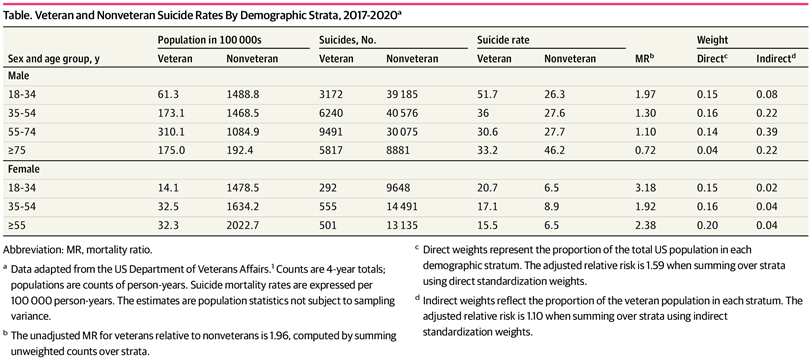Current VA Model Shows 1.57 to 1.55 Greater Suicide Risk

Click to Enlarge: Veteran and Nonveteran Suicide Rates By Demographic Strata, 2017-2020 Source: JAMA Network Open
ARLINGTON, VA — By any measure, suicide rates for veterans are higher than the general U.S. population; how much higher, however, can vary greatly by how the comparison group is defined.
As it stands now, the VA estimates that, between 2017 and 2020, veteran suicide rates were 1.57 to 1.66 times greater than nonveterans in the United States, after adjusting for age and sex differences.
“This finding does not mean that veteran suicide rates are 1.57 to 1.66 times greater than nonveterans with the same age and sex distributions,” according to a new study in JAMA Network Open. “The U.S. government approach to age and sex adjustment compares suicide rates under counterfactual conditions in which veteran and nonveteran populations share a common age and sex distribution, namely that of the population of the U.S. in 2000.”
The RAND Corp. authors compared the relative risk of suicide among veterans and nonveterans using the government’s method called direct standardization but also utilized an alternative approach that compares the true veteran population with an age- and sex-matched nonveteran population, called indirect standardization.
The researchers aggregated and used four years (2017-2020) of data published by the VA on suicide counts and population sizes for veterans and nonveterans, calculating veterans’ relative risk of suicide using two standard procedures.
The RAND team first compared suicide rates using a direct standardization approach, then it compared those rates using indirect standardization.
“The veteran population is older and includes a much higher percentage of men than does the nonveteran population,” according to the research letter. “These differences, and differences in the relative risk of suicide within these strata, lead to notable differences in estimates produced by the two methods. Although both methods show veteran risk as elevated relative to nonveterans, the direct method produces an adjusted mortality ratio of 1.59, nearly six times greater elevation in risk than found by indirect standardization, which produces a standardized mortality ratio of 1.10.”
Why the difference? The authors explained, “Direct standardization gives far more weight to the relatively small groups of young and female veterans compared with indirect standardization, precisely the groups for which veteran suicide risk is the highest relative to nonveterans.”
The study advised that both direct and indirect standardization are accepted methods of producing adjusted comparisons of mortality rates. “Direct standardization is especially useful for comparing disease burdens across several groups, but the absolute value of such weighted rates ‘have no intrinsic meaning,’” the authors explained, “and do not correspond to the actual mortality risk of either of the populations being compared. When a group is demographically dissimilar from the reference population, as are veterans compared with the U.S. population, direct estimates are strongly weighted toward the relative mortality risk of groups least well represented in the reference population used for standardization.”
They pointed out that an advantage of the indirect standardization approach is that it counts all veteran suicides as equal in establishing relative risks. On the other hand, the direct standardization approach in this case would require more than 50 additional suicides among male veterans 75 and older to affect the adjusted mortality ratio as much as a single additional suicide by a female veteran younger than 34.
“Due to the large differences in relative suicide risk across strata, age- and sex-specific mortality ratios are the most useful statistics for most purposes,” the report concluded. “When an aggregate statistic is required to compare suicide risk among veterans and nonveterans, the correct interpretation of indirect standardization results might be more easily conveyed to general audiences because it compares actual veteran suicide rates with those of similar nonveterans.”
- Morral AR, Schell TL, Smart R. Comparison of Suicide Rates Among US Veteran and Nonveteran Populations. JAMA Netw Open. 2023;6(7):e2324191. doi:10.1001/jamanetworkopen.2023.24191
